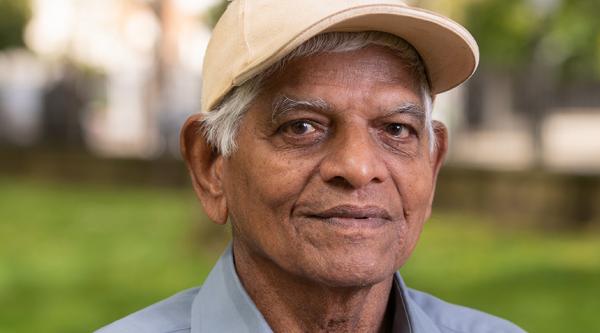Dementia-Friendly Heritage Guide Launches at Hampton Court Palace
Guide to making heritage more dementia-friendly launched with support of Alzheimer’s Society Ambassador Sir Tony Robinson.
In an industry first, heritage sites across the country joined forces this week to launch a pioneering guide to making Britain’s stately homes, museums and parks commit to becoming more dementia-friendly.
The guide, championed by the Alzheimer’s Society and the Heritage Lottery Fund, is the result of a collaboration between a group of heritage organisations, including Historic Royal Palaces, and English Heritage and can be downloaded on our website.
A rallying call for the sector to stand united against dementia and become more dementia-friendly, it includes practical advice from sites across the country who have been experimenting with innovative ways to engage visitors with dementia.
Heritage properties form an integral part of our national story and landscape. Often at the heart of local communities, they are regularly visited by people of all ages, to reminisce, to explore history, and importantly, to relax.
However, these sites can be intimidating places for the 850,000 people in the UK currently living with dementia.
They can be unpredictable spaces, which are disorientating and complicated to navigate. The complex history and timelines they explore can prove challenging for people with memory problems. The guide highlights a number of creative ways heritage organisations have been responding to this challenge.
- The Big Pit National Coal Museum in South Wales have worked with Google Expeditions to give visitors with dementia a preview of their underground tour, so they know what to expect.
- Historic Royal Palaces staged ‘Sensory Palaces’ sessions at Hampton Court Palace where people living with dementia can explore King Henry VIII’s court using their senses.
- Chatsworth House have even delivered an ‘Armchair Gallery’ to residents in care homes across Nottinghamshire.
Catering for people with dementia makes good business sense for heritage organisations. Heritage sites often rely on older audiences, who generate 20% of the sector’s income.
People living with dementia want to be able to continue to do things they enjoy doing. Failing to adapt to their needs could prove costly: the more accessible the experience for people living with dementia, the more likely heritage sites are to retain existing visitors, and reach new ones.
Sir Tony Robinson who has endorsed this guide, Alzheimer’s Society Ambassador, said:
‘Britain is steeped in history and remarkable places of natural beauty. We all enjoy stepping back in time and following in the footsteps of Roman soldiers or relaxing in the gardens of a majestic country house.
'Visiting heritage sites is one of the most popular activities that people with dementia want to continue doing. Heritage sites can play a crucial role in supporting people with dementia to enjoy a connection with the places they love and help to improve their well-being.’
Kim Klug, Learning Producer, Historic Royal Palaces, who co-authored the guide, said:
‘Our guide is just the beginning of a campaign to help heritage sites across the country adapt and become more dementia-friendly. Collaborating on this resource with colleagues across the sector has been hugely inspiring and proof that we can respond creatively to make our sites as accessible as possible.
'We have a huge opportunity to improve the quality of life of people living with dementia – hopefully this guide will inspire even more sites to take up the challenge!’
Emma Bould, Programme Partnerships Project Manager at Alzheimer’s Society said:
'Alzheimer’s Society is delighted to be launching the first ever Dementia Friendly Heritage Guide in partnership with Historic Royal Palaces and is calling upon heritage organisations across the UK to unite against dementia and sign up to their campaign to commit to becoming a dementia-friendly organisation.
'Heritage sites have an important part to play in tackling the social impact of dementia, by enabling people living with condition to feel confident and welcomed to get out and about in their local community.
'Visiting a heritage site can promote activity and stimulation of the mind, improving physical and mental health by keeping active. The importance of such venues increases as we get older, as a place to relax, recover and engage through multi-sensory stimulation of the space around us.
'We know through projects like our Side by Side service that visiting a heritage site is one of the most popular activities for older people affected by dementia and something they are keen to continue doing throughout their condition. We hope this guide will encourage other heritage sites across the UK to sign up and commit to becoming dementia-friendly by taking practical steps to improve their stores and services for people affected by dementia.'








